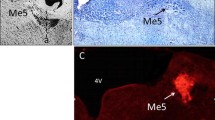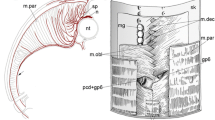Summary
The syrinx of songbirds includes two separate sound sources, the internal tympaniform membranes (ITM), which form the medial wall of each bronchus. The performance of each ITM is controlled by the muscles of that syringeal half. In the canarySerinus canarius, hypoglossal fibers reaching the syrinx via the tracheosyringealis branch of the hypoglossus are responsible for sound modulation. The muscles controlling the performance of the left syringeal half are innervated solely by the left tracheosyringealis; those controlling the right syringeal half are innervated only by the right tracheosyringealis. In the canary and white-crowned sparrow (Zonotrichia leucophrys) a great majority of song elements disappears after section of the left tracheosyringealis, yet remains intact after section of the right one. This phenomenon, earlier described in the chaffinch (Nottebohm, 1970, 1971, 1972) and confirmed in the white-throated sparrow (Lemon, 1973), has been called left hypoglossal dominance. Left hypoglossal dominance occurs in canaries with small or large song repertoires. It occurs in chronically deafened canaries that never had access to their own auditory feedback; it also occurs in birds that had the right or left cochlea removed at an early age. To this extent, left hypoglossal dominance seems to emerge in the individual as a motor phenomenon.
Similar content being viewed by others
References
Borror, D.J., Reese, C.R.: Vocal gymnastics in wood thrush songs. Ohio J. Sci.56, 177–182 (1956)
Chamberlain, D.R., Gross, W.B., Cornwell, G.W., Mosby, H.S.: Syringeal anatomy in the common crow. Auk85, 244–252 (1968)
Conrad, R.: Untersuchungen über den unteren Kehlkopf der Vögel. I. Zur Kenntnis der Innervierung. Z. wiss. Zool.114, 532–576 (1915)
Dürrwang, R.: Funktionelle Biologie, Anatomie und Physiologie der Vogelstimme. Doctoral Dissertation, Univ. Basel 1974
Gaunt, A.S., Wells, M.K.: Models of syringeal mechanisms. Amer. Zool.13, 1227–1247 (1973)
Greenewalt, C.H.: Bird song, acoustics and physiology. Washington, D.C.: Smithsonian Institution Press 1968
Hersch, G.L.: Bird voices and resonant tuning in helium-air mixtures. Doctoral Dissertation, Univ. of Calif, Berkeley 1966
Hopkins, C.D., Rosetto, M., Lutjen, A.: A continuous sound spectrum analyzer for animal sounds. Z. Tierpsychol.34, 313–320 (1974)
Kimura, D.: Some effects of temporal-lobe damage on auditory perception. Canad. J. Psychol.15, 156–165 (1961a)
Kimura, D.: Cerebral dominance and the perception of verbal stimuli. Canad. J. Psychol.15, 166–171 (1961b)
Kimura, D.: Functional asymmetry of the brain in dichotic listening. Cortex3, 163–178 (1967)
Klatt, D.H., Stefanski, R.A.: How does a mynah bird imitate human speech? J. acoust. Soc. Amer.55, 822–832 (1974)
Konishi, M.: Effects of deafening on song development in two species of juncos. Condor66, 85–102 (1964)
Konishi, M.: The role of auditory feedback in the control of vocalizations in the White-crowned sparrow. Z. Tierpsychol.22, 770–783 (1965)
Lemon, R.E.: Nervous control of the syrinx in white-throated sparrows (Zonotrichia albicollis). J. Zool. (Lond.)171, 131–140 (1973)
Marler, P.: A comparative approach to vocal learning: song development in white-crowned sparrows. J. comp. physiol. Psychol.71, Monogr., 25 (1970)
Marler, P., Konishi, M., Lutjen, A., Waser, M.S.: Effects of continuous noise on avian hearing and vocal development. Proc. nat. Acad. Sci. (Wash.)70, 1393–1396 (1973)
Marler, P., Tamura, M.: Song dialects in three populations of white-crowned sparrows. Condor64, 368–377 (1962)
Marler, P., Tamura, M.: Culturally transmitted patterns of vocal behavior in sparrows. Science146, 1483–1486 (1964)
Metfessel, M.: Roller canary song produced without learning from external source. Science81, 470 (1935)
Miskimen, M.: Sound production in passerine birds. Auk68, 493–504 (1951)
Molfese, D.L., Freeman, R.B., Palermo, D.S.: The ontogeny of brain lateralization for speech and nonspeech stimuli. Brain and Language2, 356–368 (1975)
Nottebohm, F.: Auditory experience and song development in the chaffinch,Fringilla coelebs. Ibis110, 549–568 (1968)
Nottebohm, F.: Ontogeny of bird song. Science167, 950–956 (1970)
Nottebohm, F.: Neural lateralization of vocal control in a passerine bird. I. Song. J. exp. Zool.177, 229–262 (1971)
Nottebohm, F.: Neural lateralization of vocal control in a passerine bird. II. Subsong, calls, and a theory of vocal learning. J. exp. Zool.179, 35–50 (1972)
Nottebohm, F.: Vocal behavior in birds. In: Avian biology (eds. D.S. Farner, J.R. King) New York: Academic Press 1975
Nottebohm, F., Stokes, T.M., Leonard, C.M.: Central control of song in the canary,Serinus canarius. J. comp. Neurol.165, 457–486 (1976)
Poulsen, H.: Inheritance and learning in the song of the chaffinch (Fringilla coelebs). Behaviour3, 216–228 (1951)
Poulsen, H.: Song learning in the domestic canary. Z. Tierpsychol.16, 173–178 (1959)
Rosenzweig, M.R.: Representations of the two ears at the auditory cortex. Amer. J. Physiol.167, 147–158 (1951)
Thorpe, W.H.: The learning of song patterns by birds, with special reference to the song of the chaffinch,Fringilla coelebs. Ibis100, 535–570 (1958)
Tunturi, A.R.: A study on the pathway from the medial geniculate body to the acoustic cortex in the dog. Amer. J. Physiol.147, 311–319 (1946)
Youngren, O.M., Peek, F.W., Phillips, R.E.: Repetitive vocalizations evoked by local electrical stimulation of avian brains. Brain, Behav. Evol.9, 393–421 (1974)
Author information
Authors and Affiliations
Additional information
We wish to thank Betsy Manning for all the time and effort she spent recording the song of our birds. We are also indebted to Professor Peter Marler, Rockefeller University, for letting us include in our study several birds which he reared in noise and which formed part of an earlier experiment (Marler et al., 1973). Our research was supported by NIH grant MH 18343.
About this article
Cite this article
Nottebohm, F., Nottebohm, M.E. Left hypoglossal dominance in the control of canary and white-crowned sparrow song. J. Comp. Physiol. 108, 171–192 (1976). https://doi.org/10.1007/BF02169047
Received:
Issue Date:
DOI: https://doi.org/10.1007/BF02169047




